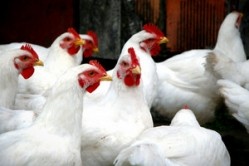As feed prices climb, US chicken industry lobby requests ethanol limit

Mike Brown, president of the council, said the NCC agreed with the decision of the US Environmental Protection Agency (EPA) to propose lower target levels for ethanol production. However, he also wants the amounts set out in the RFS for 2015 and 2016, in terms of ethanol output, to be further reduced.
The original levels for total conventional biofuel production, including ethanol, set for 2014, 2015 and 2016 were 14 billion gallons, 15 billion gallons and 15 billion gallons respectively. In a proposed update to the RFS, the new targets, if approved this fall, would be 13.25 billion gallons, 13.4 billion gallons and 14 billion gallons for 2014, 2015 and 2016, respectively.
“NCC strongly believes this adjustment is necessary and that lowering the proposed target levels from the recommended statutory levels prescribed by the Energy Independence and Security Act of 2007 (EISA) are an important step toward ensuring the RFS reflects reasoned economic and environmental policy,” said Brown.
While the council supports the ideas behind the creation of biofuel, and use of a renewable fuel source, the current process also exacts a price from members of the poultry industry and consumers, he added.
Increasing feed prices
Most poultry producers use corn as a feed, said Brown. A reduction in the amount of corn dedicated to the ethanol industry would ease the feed prices paid by producers and those passed on to consumers.
“The diversion of corn into ethanol production, when mandated by the RFS or influenced by the RFS regulatory process as it was in 2014 absent final regulations, has created an uneven playing field for chicken companies to compete for necessary feedstuffs,” said Brown. “Since the RFS was enacted, chicken companies have faced more than $50 billion in higher actual feed costs due to the RFS.”
Regulation of the market
Other factors also influence the feed corn market, like supply and demand, global markets and weather, said Brown. However, the dedication of a certain amount of the corn crop to ethanol production obscures some of these traditional market trends.
“Because the RFS sets an enforceable mandate for the amount of corn that must be utilized as ethanol feedstock, regardless of the price of corn, or the supply of corn, the RFS-driven demand for corn as ethanol feedstock is highly inelastic and has had a dramatic impact on corn prices since 2007,” he said.
Consequently, a slight shock to the system from a poor crop yield causes a dramatic increase in prices, he said.
The broiler industry watched this happen in both 2009 and 2012, when a marked uptick in corn prices meant that producers had a harder time feeding birds, said Brown. Those flock reductions or the limitations placed on flock growth had lasting repercussions.
“In short, the RFS provides ethanol mills with an advantage when buying corn, especially when there is some other economic shock to the market, like drought in previous years, or the flooding that has impacted corn prices so far this year,” he said.
This year the spring forecast World Agricultural Supply and Demand Estimates (WASDE) report from the US Department of Agriculture had corn prices ranging from $3.20-$3.80, with crop yields splitting and about 5.2 billion bushels of corn going for ethanol production and 5.3 billion bushels being for feed or residential use.
But, by July’s WASDE report, expectations had shifted so that with a smaller overall corn crop slightly more would be going to ethanol and about 5.27 billion bushels were destined for feed and residential use. Additionally, the price of corn was expected to raise to a range of $3.45-$4.05 a bushel.
“These figures illustrate the dramatic advantage the RFS provides to the ethanol industry at the expense of other corn users, particularly when other factors drive up the price of corn,” said Brown.
Production and export of ethanol
The highest consumption of corn-based ethanol happened in 2014, a year when a target volume were still in review, he said. The new amounts proposed in the revised RFS would further increase that level, even if they lower volume recommendations when compared with earlier versions of the RFS.
“To be clear, despite the biofuel industry’s characterization of EPA’s proposed 2015 and 2016 required volume obligations as reducing ethanol levels based on the benchmark of the volumes provided by the EISA, those proposed volumes actually increase the ethanol mandate beyond its record consumption levels,” said the council president.
In addition to domestic use, there also has been an increase in the export market for ethanol, he said. That usage does little to meet many of the original intentions of the RFS.







